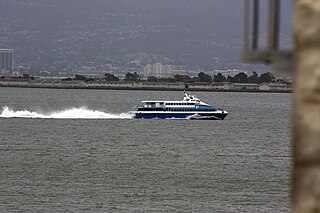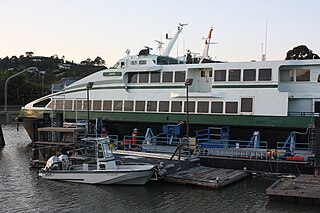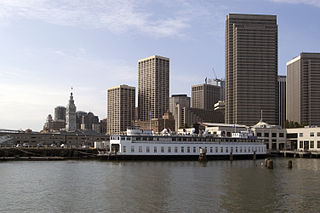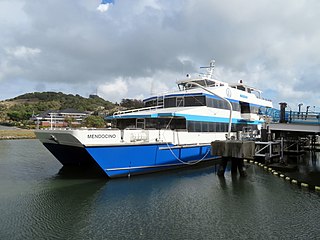Related Research Articles
A ferry is a watercraft that carries passengers, and sometimes vehicles and cargo, across a body of water. A small passenger ferry with many stops, such as in Venice, Italy, is sometimes called a water taxi or water bus.

The Alaska Marine Highway (AMH) or the Alaska Marine Highway System (AMHS) is a ferry service operated by the U.S. state of Alaska. It has its headquarters in Ketchikan, Alaska.

MV Fairweather is a catamaran ferry built by Derecktor Shipyards in Bridgeport, Connecticut for the Alaska Marine Highway System entering service 2004. After being laid up since 2019, in March 2021 it was sold to Servicios y Concesiones Maritimas Ibicencas for service between Mallorca and Menorca.

The MV Nisqually was a Steel Electric-class ferry formerly operated by Washington State Ferries.

MV Golden Gate is a passenger-only fast ferry operated by Golden Gate Ferries.

MV Napa is a passenger-only fast ferry operated by Golden Gate Ferry in the northern Bay Area in California, United States.

The MV Quinault was a Steel Electric-class ferry operated by Washington State Ferries.

The Steel Electric-class ferries are a class of auto/passenger ferries that became part of the Washington State Ferry System when Puget Sound Navigation Company was acquired in 1951. They were built in San Francisco Bay for service on Southern Pacific and Northwestern Pacific Railroad routes across the bay.

A high-speed craft (HSC) is a high-speed water vessel for civilian use, also called a fastcraft or fast ferry. The first high-speed craft were often hydrofoils or hovercraft, but in the 1990s catamaran and monohull designs become more popular. Most high-speed craft serve as passenger ferries, but the largest catamarans and monohulls also carry cars, buses, large trucks and freight.

Manly ferry services operate on Sydney Harbour connecting the Sydney suburb of Manly with Circular Quay in the CBD, a journey of seven nautical miles.

Golden Gate Ferry is a commuter ferry service operated by the Golden Gate Bridge, Highway and Transportation District in San Francisco Bay, part of the Bay Area of Northern California, United States. Regular service is run to the Ferry Building in San Francisco from Larkspur, Sausalito, Tiburon, and Angel Island in Marin County, with additional service from Larkspur to Oracle Park and Chase Center. The ferry service is funded primarily by passenger fares and Golden Gate Bridge tolls. In 2023, Golden Gate Ferry had a ridership of 1,299,200, or about 3,500 per weekday as of the first quarter of 2024.

Santa Rosa was a Steel Electric-class ferry built in Alameda, California, for Northwestern Pacific Railroad. She started out serving Southern Pacific Railways on their Golden Gate Ferries line on San Francisco Bay.

The Edmonds–Kingston ferry is a ferry route across Puget Sound between Edmonds and Kingston, Washington. Since 1951 the only ferries employed on the route have belonged to the Washington state ferry system, currently the largest ferry system in the United States. The last regularly operated steam ferry on the West Coast of the United States made its final run on this route in 1969.

The Seattle–Bremerton ferry is a ferry route across Puget Sound between Seattle and Bremerton, Washington. Since 1951, the route has primarily been operated by the state-run Washington State Ferries system, currently the largest ferry system in the United States. Kitsap Transit also runs passenger-only "fast ferries" service on the route.

The M/V Del Norte is a passenger-only fast ferry operated by Golden Gate Ferries.

The M/V Mendocino is a passenger-only fast ferry operated by Golden Gate Ferries.

The SuperCat Fast Ferry Corporation, commonly known as SuperCat, is a shipping company that operates a fleet of high-speed catamarans (HSC) in the Philippines.
The MV Willapa was a car ferry that served on the San Francisco Bay and later on Puget Sound. She was one of the Steel Electric-class ferries built in 1927 for service across the San Francisco Bay. Originally named MV Fresno, she was operated by the Southern Pacific Railroad and provided ferry service across the bay.

Kitsap Fast Ferries is a passenger ferry service operating between Seattle and Kitsap County in the U.S. state of Washington. It is funded and operated by Kitsap Transit and began service in July 2017, with a single boat traveling between Seattle and Bremerton. A second route, from Seattle to Kingston, launched in November 2018, and a third route serving Seattle and Southworth began operating in March 2021. In 2023, the system had a ridership of 1,091,400, or about 40,800 per weekday as of the first quarter of 2024.
References
- ↑ "Fast ferry lawsuit settled". Puget Sound Business Journal. April 2, 2002. Retrieved 2008-08-19.